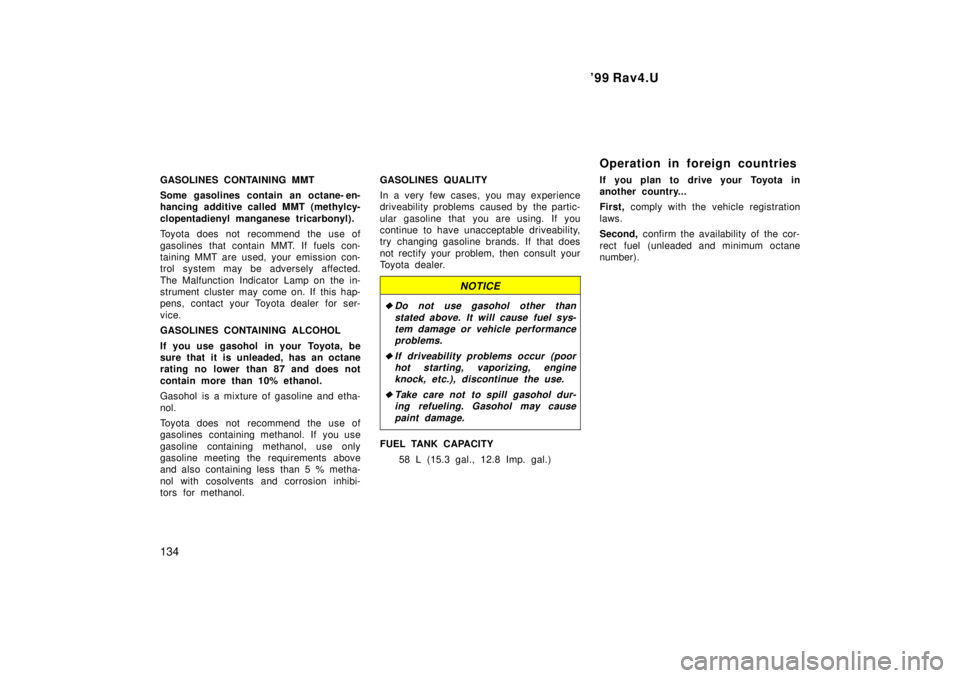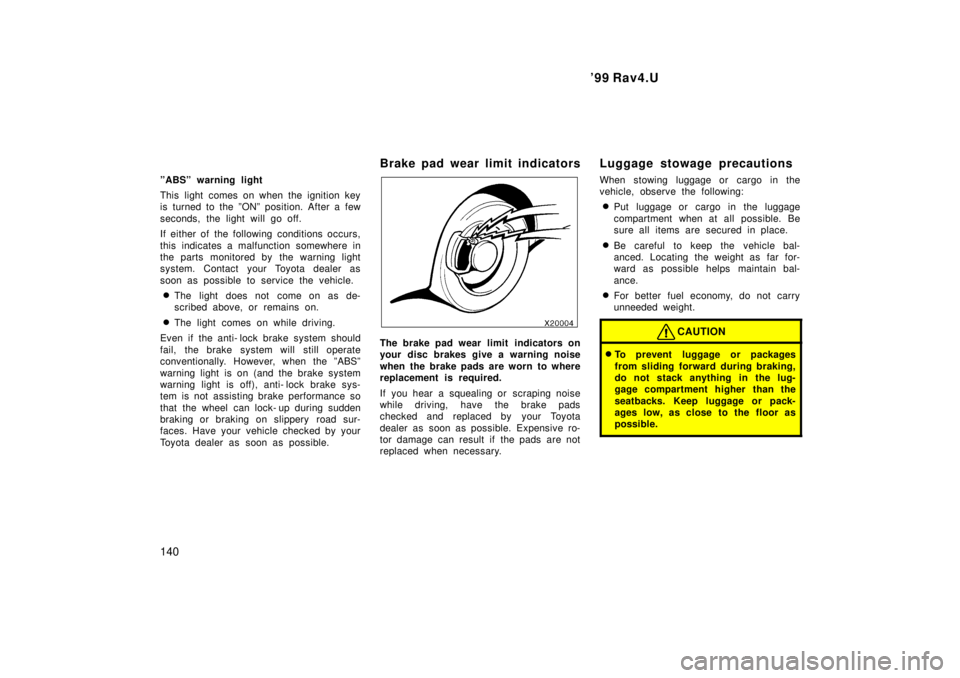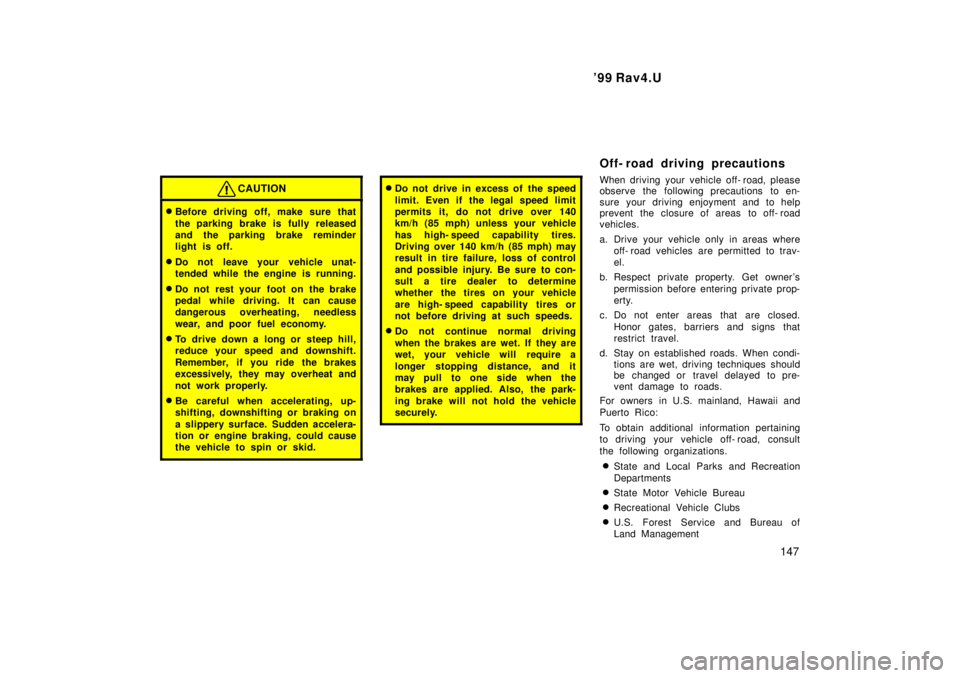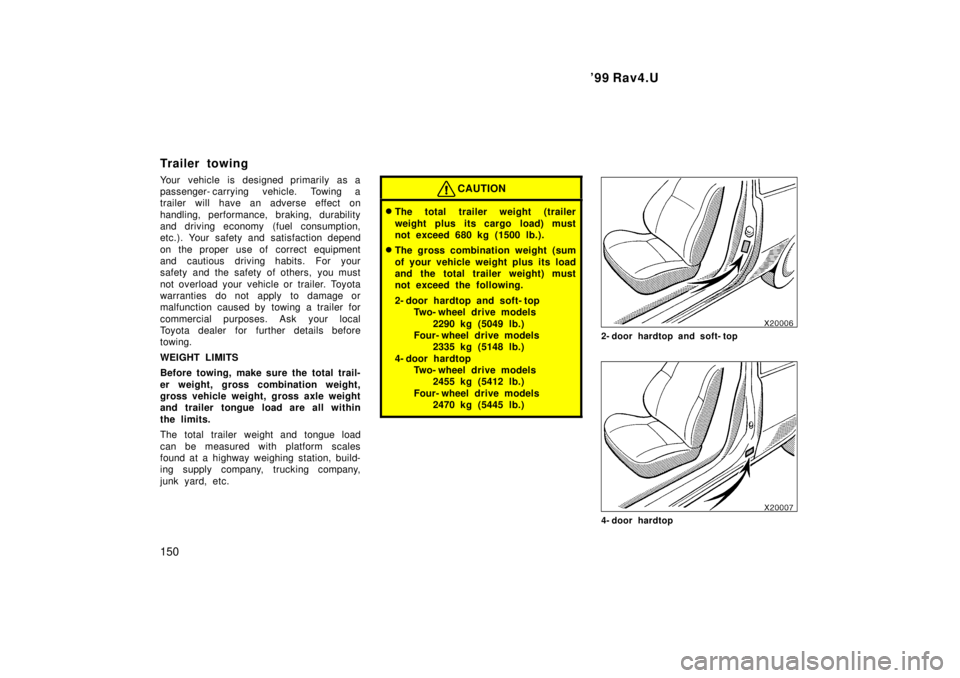1999 TOYOTA RAV4 fuel
[x] Cancel search: fuelPage 134 of 226

'99 Rav4.U
134
GASOLINES CONTAINING MMT
Some gasolines contain an octane- en-
hancing additive called MMT (methylcy-
clopentadienyl manganese tricarbonyl).
Toyota does not recommend the use of
gasolines that contain MMT. If fuels con-
taining MMT are used, your emission con-
trol system may be adversely affected.
The Malfunction Indicator Lamp on the in-
strument cluster may come on. If this hap-
pens, contact your Toyota dealer for ser-
vice.
GASOLINES CONTAINING ALCOHOL
If you use gasohol in your Toyota, be
sure that it is unleaded, has an octane
rating no lower than 87 and does not
contain more than 10% ethanol.
Gasohol is a mixture of gasoline and etha-
nol.
Toyota does not recommend the use of
gasolines containing methanol. If you use
gasoline containing methanol, use only
gasoline meeting the requirements above
and also containing less than 5 % metha-
nol with cosolvents and corrosion inhibi-
tors for methanol.
GASOLINES QUALITY
In a very few cases, you may experience
driveability problems caused by the partic-
ular gasoline that you are using. If you
continue to have unacceptable driveability,
try changing gasoline brands. If that does
not rectify your problem, then consult your
Toyota dealer.
NOTICE
�Do not use gasohol other than
stated above. It will cause fuel sys-tem damage or vehicle performanceproblems.
�If driveab ility problems occur ( poor
hot starting, vaporizing, engine knock, etc.), discontinue the use.
�Take care not to spill gasohol dur-
ing refueling. Gasohol may cause
paint damage.
FUEL TANK CAPACITY
58 L (15.3 gal., 12.8 Imp. gal.) Operation in foreign countries
If you plan to drive your Toyota in
another country...
First,
comply with the vehicle registration
laws.
Second, confirm the availability of the cor-
rect fuel (unleaded and minimum octane
number).
Page 135 of 226

'99 Rav4.U135
Three- way catalytic converter
Ty p e A
Ty p e B
The three- way catalytic converter is an
emission control device installed in the
exhaust system.
The purpose is to reduce pollutants in the
exhaust gas.
CAUTION
�
Keep people and combustible mate-
rials away from the exhaust pipe
while the engine is running. The
exhaust gas is very hot.
� Do not drive, idle or park your ve-
hicle over anything that might burn
easily such as grass, leaves, paper
or rags.
NOTICE
A large amount of unburned gases
flowing into the three- way catalyticconverter may cause it to overheat and create a fire hazard. To prevent
this and other damage, observe thefollowing precautions:
�Use only unleaded gasoline.
�Do not drive with an extremely low
fuel level; running out of fuel couldcause the engine to misfire, creat-ing an excessive load on the three-
way catalytic converter.
�Do not allow the engine to run atidle speed for more than 20 min-
utes.
�Avoid racing the engine.
�Do not push- start or pull- start yourvehicle.
�Do not turn off the ignition while
the vehicle is moving.
�Keep your engine in good runningorder. Malfunctions in the engineelectrical system, electronic ignition
system/distributor ignition systemor fuel systems could cause an ex-
tremely high three- way catalytic
converter temperature.
�If the engine becomes difficult tostart or stalls frequently, take your
vehicle in for a check- up as soonas possible. Remember, your Toyota dealer knows your vehicle and its
three- way catalytic converter sys-tem best.
Page 137 of 226

'99 Rav4.U137
FUNCTIONS OF ENGINE OIL
Engine oil has the primary functions of
lubricating and cooling the inside of the
engine, and plays a major role in main-
taining the engine in proper working order.
ENGINE OIL CONSUMPTION
It is normal that an engine should con-
sume some engine oil during normal
engine operation. The causes of oil
consumption in a normal engine are as
follows.
� Oil is used to lubricate pistons, piston
rings and cylinders. A thin film of oil
is left on the cylinder wall when a pis-
ton moves downwards in the cylinder.
High negative pressure generated when
the vehicle is decelerating sucks some
of this oil into the combustion chamber.
This oil as well as some part of the oil
film left on the cylinder wall is burned
by the high temperature combustion
gases during the combustion process. �
Oil is also used to lubricate the stems
of the intake valves. Some of this oil
is sucked into the combustion chamber
together with the intake air and is
burned along with the fuel. High tem-
perature exhaust gases also burn the
oil used to lubricate the exhaust valve
stems.
The amount of engine oil consumed de-
pends on the viscosity of the oil, the
quality of the oil and the conditions the
vehicle is driven under.
More oil is consumed by high- speed driv-
ing and frequent acceleration and decel-
eration.
A new engine consumes more oil, since
its pistons, piston rings and cylinder walls
have not become conditioned.
When judging the amount of oil con-
sumption, note that the oil may become
diluted and make it difficult to judge
the true level accurately.
As an example, if a vehicle is used for
repeated short trips, and consumes a nor-
mal amount of oil, the dipstick may not
show any drop in the oil level at all, even
after 1000 km (600 miles) or more. This
is because the oil is gradually becoming
diluted with fuel or moisture, making it
appear that the oil level has not changed. The diluting ingredients evaporate out
when the vehicle is then driven at high
speeds, as on an expressway, making it
appear that oil is excessively consumed
after driving at high speeds.
IMPORTANCE OF ENGINE OIL LEVEL CHECK
One of the most important points in prop-
er vehicle maintenance is to keep the en-
gine oil at the optimum level so that oil
function will not be impaired. Therefore, it
is essential that the oil level be checked
regularly. Toyota recommends that the oil
level be checked every time you refuel
the vehicle.
NOTICE
Failure to check the oil level regularly
could lead to serious engine troubledue to insufficient oil.
For detailed information on oil level check,
see ºChecking the engine oil levelº in
Chapter 7- 2.
Facts about engine oil
consumption
Page 140 of 226

'99 Rav4.U
140
ºABSº warning light
This light comes on when the ignition key
is turned to the ºONº position. After a few
seconds, the light will go off.
If either of the following conditions occurs,
this indicates a malfunction somewhere in
the parts monitored by the warning light
system. Contact your Toyota dealer as
soon as possible to service the vehicle.
� The light does not come on as de-
scribed above, or remains on.
� The light comes on while driving.
Even if the anti- lock brake system should
fail, the brake system will still operate
conventionally. However, when the ºABSº
warning light is on (and the brake system
warning light is off), anti- lock brake sys-
tem is not assisting brake performance so
that the wheel can lock- up during sudden
braking or braking on slippery road sur-
faces. Have your vehicle checked by your
Toyota dealer as soon as possible. Brake pad wear limit indicators
The brake pad wear limit indicators on
your disc brakes give a warning noise
when the brake pads are worn to where
replacement is required.
If you hear a squealing or scraping noise
while driving, have the brake pads
checked and replaced by your Toyota
dealer as soon as possible. Expensive ro-
tor damage can result if the pads are not
replaced when necessary.Luggage stowage pr
ecautions
When stowing luggage or cargo in the
vehicle, observe the following: � Put luggage or cargo in the luggage
compartment when at all possible. Be
sure all items are secured in place.
� Be careful to keep the vehicle bal-
anced. Locating the weight as far for-
ward as possible helps maintain bal-
ance.
� For better fuel economy, do not carry
unneeded weight.CAUTION
�To prevent luggage or packages
from sliding forward during braking,
do not stack anything in the lug-
gage compartment higher than the
seatbacks. Keep luggage or pack-
ages low, as close to the floor as
possible.
Page 145 of 226

'99 Rav4.U145
Part 3
STARTING AND DRIV-
ING �
Before starting the engine
�How to start the engine
�Tips for driving in various
conditions
�Off- road driving precautions
�Winter driving tips
�Tr ailer towing
�How to save fuel and make your
vehicle last longer, too
Before starting the engine
1. Check the area around the vehicle be- fore entering it.
2. Adjust seat position, seatback angle, head restraint height and steering
wheel angle.
3. Adjust inside and outside rear view mirrors.
4. Lock side doors, back door (hardtop) and tailgate (soft- top).
5. Fasten seat belts. 1. Apply the parking brake firmly.
2. Turn off unnecessary lights and acces-
sories.
3. Manual transmission: Press the clutch
pedal to the floor and shift the trans-
mission into neutral. Hold the clutch
pedal to the floor until the engine is
started. A starter safety device will pre-
vent the starter from operating if the
clutch pedal is not fully depressed.
Automatic transmission: Put the se-
lector lever in ºPº. If you need to re-
start the engine while the vehicle is
moving, put the selector lever in ºNº.
A starter safety device will prevent the
starter from operating if the selector
lever is in any drive position.
4. Automatic transmission only: De-
press the brake pedal and hold it to
the floor until driving off.
How to start the engineÐ
(a) Before cranking
Page 146 of 226

'99 Rav4.U
146
(b) Starting the engine
Before starting the engine, be sure to fol-
low the instructions in º(a) Before crank-
ingº.
Normal starting procedure
The multiport fuel injection system/sequen-
tial multiport fuel injection system in your
engine automatically controls the proper
air- fuel mixture for starting. You can start
a cold or hot engine as follows:
1. With your foot off the accelerator ped- al, crank the engine by turning the key
to ºSTARTº. Release it when the en-
gine starts.
2. After the engine runs for about 10 se- conds, you are ready to drive.
If the weather is below freezing, let the
engine warm up for a few minutes before
driving.
If the engine stalls...
Simply restart it, using the correct proce-
dure given in normal starting.
If the engine will not start...
See ºIf your vehicle will not startº in Part 4.
NOTICE
�Do not crank for more than 30 se- conds at a time. This may overheatthe starter and wiring systems.
�Do not race a cold engine.
�If the engine becomes difficult tostart or stalls frequently, have the
engine checked immediately.
� Always slow down in gusty crosswinds.
This will allow you much better control.
� Drive slowly onto curbs and, if pos-
sible, at a right angle. Avoid driving
onto high, sharp- edged objects and
other road hazards. Failure to do so
can lead to severe tire damage result-
ing in tire bursts.
� When parking on a hill, turn the front
wheels until they touch the curb so
that the vehicle will not roll. Apply the
parking brake, and place the transmis-
sion in ºPº (automatic) or in first or
reverse (manual). If necessary, block
the wheels.
� Washing your vehicle or driving through
deep water may get the brakes wet. To
see whether they are wet, check that
there is no traffic near you, and then
press the pedal lightly. If you do not
feel a normal braking force, the brakes
are probably wet. To dry them, drive
the vehicle cautiously while lightly
pressing the brake pedal with the park-
ing brake pulled. If they still do not
work safely, pull to the side of the road
and call a Toyota dealer for assistance.
Tips for driving in various
conditions
Page 147 of 226

'99 Rav4.U147
CAUTION
�Before driving off, make sure that
the parking brake is fully released
and the parking brake reminder
light is off.
� Do not leave your vehicle unat-
tended while the engine is running.
� Do not rest your foot on the brake
pedal while driving. It can cause
dangerous overheating, needless
wear, and poor fuel economy.
� To drive down a long or steep hill,
reduce your speed and downshift.
Remember, if you ride the brakes
excessively, they may overheat and
not work properly.
� Be careful when accelerating, up-
shifting, downshifting or braking on
a slippery surface. Sudden accelera-
tion or engine braking, could cause
the vehicle to spin or skid.
�Do not drive in excess of the speed
limit. Even if the legal speed limit
permits it, do not drive over 140
km/h (85 mph) unless your vehicle
has high- speed capability tires.
Driving over 140 km/h (85 mph) may
result in tire failure, loss of control
and possible injury. Be sure to con-
sult a tire dealer to determine
whether the tires on your vehicle
are high- speed capability tires or
not before driving at such speeds.
� Do not continue normal driving
when the brakes are wet. If they are
wet, your vehicle will require a
longer stopping distance, and it
may pull to one side when the
brakes are applied. Also, the park-
ing brake will not hold the vehicle
securely.
Off- road driving precautions
When driving your vehicle off- road, please
observe the following precautions to en-
sure your driving enjoyment and to help
prevent the closure of areas to off- road
vehicles.
a. Drive your vehicle only in areas where
off- road vehicles are permitted to trav-
el.
b. Respect private property. Get owner 's permission before entering private prop-
erty.
c. Do not enter areas that are closed. Honor gates, barriers and signs that
restrict travel.
d. Stay on established roads. When condi- tions are wet, driving techniques should
be changed or travel delayed to pre-
vent damage to roads.
For owners in U.S. mainland, Hawaii and
Puerto Rico:
To obtain additional information pertaining
to driving your vehicle off- road, consult
the following organizations.
� State and Local Parks and Recreation
Departments
� State Motor Vehicle Bureau
� Recreational Vehicle Clubs
� U.S. Forest Service and Bureau of
Land Management
Page 150 of 226

'99 Rav4.U
150
Trailer towing
Your vehicle is designed primarily as a
passenger- carrying vehicle. Towing a
trailer will have an adverse effect on
handling, performance, braking, durab
ility
and driving economy (fuel consumption,
etc.). Your safety and satisfaction depend
on the proper use of correct equipment
and cautious driving habits. For your
safety and the safety of others, you must
not overload your vehicle or trailer. Toyota
warranties do not apply to damage or
malfunction caused by towing a trailer for
commercial purposes. Ask your local
Toyota dealer for further details before
towing.
WEIGHT LIMITS
Before towing, make sure the total trail-
er weight, gross combination weight,
gross vehicle weight, gross axle weight
and trailer tongue load are all within
the limits.
The total trailer weight and tongue load
can be measured with platform scales
found at a highway weighing station, build-
ing supply company, trucking company,
junk yard, etc.
CAUTION
� The total trailer weight (trailer
weight plus its cargo load) must
not exceed 680 kg (1500 lb.).
� The gross combination weight (sum
of your vehicle weight plus its load
and the total trailer weight) must
not exceed the following.
2- door hardtop and soft- top
Two- wheel drive models
2290 kg (5049 lb.)
Four- wheel drive models 2335 kg (5148 lb.)
4- door hardtop Two- wheel drive models 2455 kg (5412 lb.)
Four- wheel drive models 2470 kg (5445 lb.)
2- door hardtop and soft- top
4- door hardtop